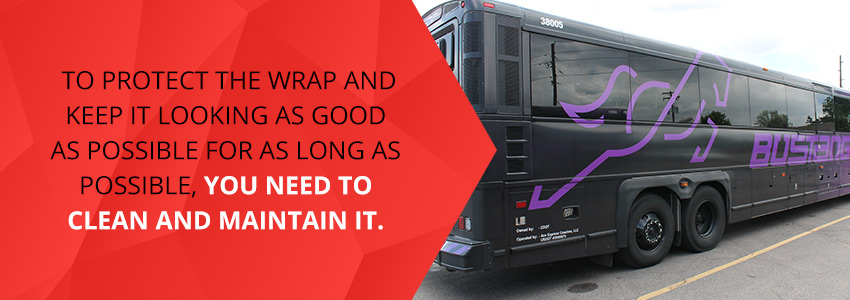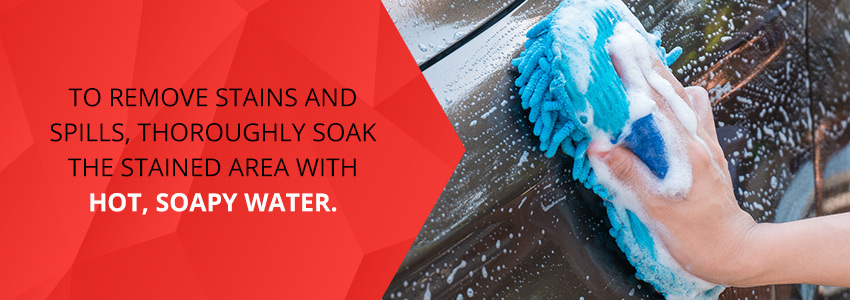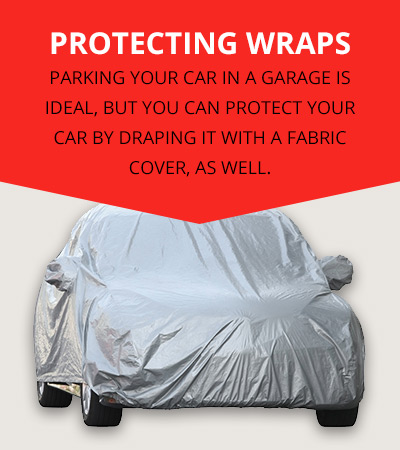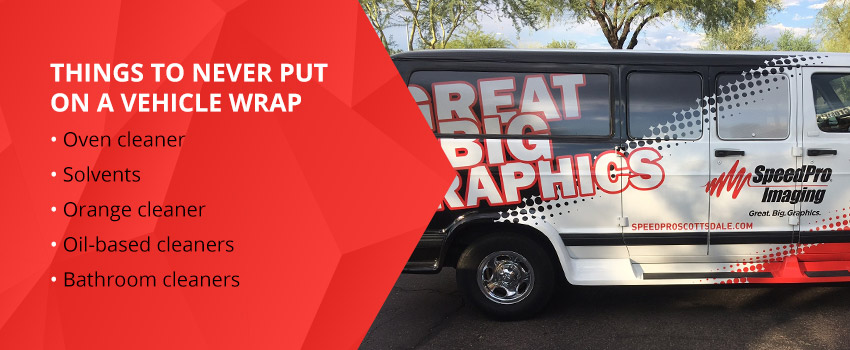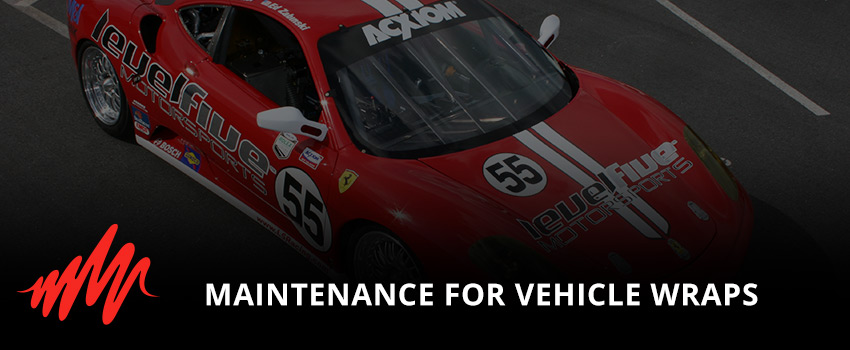
Maintenance for Vehicle Wraps
MARCH 14, 2019| SpeedProCategories
Vehicle GraphicsHere’s a scenario: You’re walking down the street in a town you’re not too familiar with. It’s lunchtime, and you’re looking for a place to eat. You come across two restaurants, side by side. They each serve a similar menu. The first restaurant looks clean as a whistle — its sign is shiny and new, its windows don’t have a smudge on them, and the furniture inside is spotless. The second restaurant doesn’t look so great. Its sign is crooked and has a layer of dust on it, its windows are streaky, and the furniture inside seems a little worse for the wear. Which restaurant would you choose?
Even if two places or objects are similar in every other way, if one isn’t well cared for or maintained, people are likely to flock to the other one. This rule remains true when it comes to vehicle wraps.
If you’re using vehicle wraps to advertise or promote your business, it’s essential that you keep them looking as good as possible. If a wrap looks dirty, worn out or uncared for, people are going to wonder what’s going on with the company. A worn out and dirty car wrap sends the not-so-subtle message that the business doesn’t care or might be neglectful.
Why You Should Clean and Maintain Vehicle Wraps
To keep your car running at its best, you bring it in for regular oil changes and maintenance. The same rule applies to your vehicle wrap. To protect the wrap and keep it looking as good as possible for as long as possible, you need to clean and maintain it. Other reasons to keep your vehicle wraps clean and well-maintained include that doing so:
- Makes the message of the wrap easy to read: If a vehicle wrap is covered in dirt and grime, it can be difficult to see the brand’s name and contact information.
- Extends the life of the vehicle wrap: Without regular care and cleaning, the lifespan of a vehicle wrap is significantly reduced.
- Creates a positive impression: If passersby see a dirty or unmaintained vehicle wrap, they’re going to wonder if the company is still in business. They might assume that the company doesn’t care about the products and services it offers since it doesn’t seem to care about the appearance of its fleet.
- Makes it easier to keep the vehicle clean: It takes a lot less elbow grease to clean up a spill or stain right after it happens compared to a few days, weeks or months later.
- Increases your confidence in your brand: Caring for something like a car wrap can help you build up a sense of pride and feel more confident in your brand and company.
Regular Maintenance for Vehicle Wraps and Graphics
Ideally, you’ll want to wash your vehicle and vehicle wrap at least once a week. If the vehicle and wrap get particularly dirty, you might need to clean them more frequently, such as two or three times per week. If you store the car in a garage or don’t use it very often, you might be able to get away with washing it every two weeks or so.
If you’ve ever washed a car before, you’re most likely familiar with the process of washing a vehicle wrap. Here’s what to do:
- Rinse the car off: Rinse the car and wrap with regular old water to remove any loose dust, dirt or other debris. You can use a hose with a nozzle spray attachment to complete this step.
- Suds up the car: Mix a mild, non-abrasive detergent with fresh water in a bucket. You can use a detergent designed specifically for washing cars or a mild laundry or dish detergent. Just check to make sure that the cleaner doesn’t contain alcohol or other harsh ingredients. It should have a pH between 5 and 9. If it’s your first time washing the wrap, test a small, out-of-the-way area first to make sure the detergent doesn’t interact with the wrap. If all is well, use a soft cloth or sponge to wash the car from roof to bottom.
- Rinse the car: Once you’ve thoroughly cleaned the car with the detergent/water mixture, use a hose to rinse it off with fresh, clean water.
- Let it dry: You can let the car air dry or use a soft microfiber cloth to dry it if you’re worried that spots will form. You can also use a squeegee to remove excess water and reduce the risk of spotting.
Hand Wash vs. Drive-Through Car Wash: Which Is Better?
Usually, hand washing a vehicle wrap is the recommended way to care for and maintain it. But what if it’s freezing outside or you have a lot of cars to wash and not a lot of time?
Although it’s not the recommended way to wash a car wrap, you can bring your vehicle to a drive-through car wash. You’ll want to keep a few things in mind if you go the drive-through rather than taking the hand washing route.
First, avoid car washes that use brushes. The automated brushes can damage the wrap by scratching its surface or by lifting portions of it off the vehicle. Second, avoid the wax option, if offered, at the end of the car wash. Most waxes contain ingredients like petroleum distillates, which can damage the surface of the wrap.
How to Pressure Wash a Vehicle Wrap
Like taking your wrapped vehicle to a car wash, pressure washing a vehicle wrap is something that’s okay but not ideal. The force of the water from a pressure washer is more likely to cause the wrap to peel, fade or chip over time. If you’re going to pressure wash your vehicle wrap, here’s what to remember:
- Use a low pressure — under 2,000 psi.
- Keep the temperature lukewarm — under 140 degrees Fahrenheit.
- Use the right angle — choose a spray nozzle that has a spray pattern that’s 40-degree wide angle.
- Hold the nozzle at the right angle — it should be perpendicular (90 degrees) to the vehicle graphic.
- Hold the nozzle at the correct distance from the wrap — at least 12 inches away from the vehicle.
Removing Stains and Spills
There might come a time when a vehicle wrap gets a small stain or spill on it. Tree sap can drip onto the wrap, a bug can get splattered on it, or a bird flying overhead might leave some droppings. If any of that happens, you don’t have to take the entire car in to be washed. You can remove the spill or stain by spot treating it.
Usually, the best way to remove sap, bird droppings or crushed insects is by thoroughly soaking the stained area with hot, soapy water. Let the soapy water sit on the stain or spill for a few minutes, then rinse with clean water and dry.
If hot, soapy water doesn’t do the trick, you might need to use something a little stronger. One option is to use a cleaner designed specifically for removing sticky stuff from cars, such as a bug or tar remover. Another option is to dilute rubbing alcohol with water (one part alcohol, two parts water) and use that to remove the spill or stain. Test the cleaner or alcohol mixture in an out-of-the-way area first to make sure it won’t damage the wrap. Apply the cleaner or mixture to the stain, then rinse away and dry completely.
If you accidentally spill gasoline on the vehicle wrap, you’ll want to take action quickly. Wipe up the fuel, then wash the car and wrap thoroughly using lukewarm water and a mild detergent.
Things That Can Damage a Vehicle Wrap
A vehicle wrap has a tough life to live — it spends much of its time outdoors in sunny or rainy conditions. It can be subject to scratches and dings thanks to rough roads. It can get bumped or damaged by curious passersby or objects on the side of the road or sidewalk. Some of the things that can damage a car wrap include:
- UV rays from the sun
- Curious creatures, from birds to rodents to insects to humans
- Pebbles and gravel on the road
- Tree and shrub branches
- Smog and other forms of air pollution
- Abrasive cleansers
- Snow, rain or ice
Fortunately, you can take steps to protect your vehicle and vehicle wrap from common sources of damage.
How to Protect a Vinyl Car Wrap
One of the best things you can do to protect your vehicle wrap from environmental damage, including UV exposure and damage from rough weather conditions, is to store the vehicle in a protected area. Parking your car in a garage is ideal, as the structure will shield it from the sun, rain and other environmental threats. A garage or covered parking area will also protect your car from tree and shrub branches, which can fall in a storm and crack or scratch a wrap.
If you don’t have access to a garage or covered parking area, you can protect your car by draping it with a fabric cover. Another option is to set up a freestanding carport and park the vehicle underneath it.
Another way to protect your vehicle wrap is to be careful when driving. Rocks and pebbles from the road can jump and scratch the surface of the wrap. Try to avoid driving on unpaved, rough roads if you can. You might also want to drive with care on the highway to avoid stirring up too much gravel and debris. Slow down over potholes and other irregularities in the road.
When on the road, pay attention to objects above your vehicle and to the left and right of it. If you drive too close to the side of the road, for example, a branch on a shrub or plant can scratch the wrap.
Cleaning your vehicle regularly will help to mitigate some of the damage caused by pollution and sun exposure. One thing to look out for is any signs of extensive damage from air pollution. If areas of the wrap are browning or look as if they’re rusty, you’re most likely dealing with some type of damage from pollution or smog. If your vehicle wrap gets to that point, the best option might be to remove the current wrap, clean the car’s surface, then apply a new wrap.
Recap: Dos and Don’ts When Caring for Fleet Wraps
You’ll want to always do the following:
- Do: Wash your car regularly.
- Do: Use a gentle cleanser.
- Do: Test a small area first to make sure the soap won’t damage the wrap.
- Do: Wash the vehicle starting at the top so that dirty water runs down to the bottom.
- Do: Use soft sponges or cloths to wash the car wrap.
- Do: Spot clean any spills or stains as soon as possible.
And here are the don’ts:
- Don’t: Use harsh or abrasive cleansers.
- Don’t: Let your vehicles sit out in rough weather.
- Don’t: Use brushes to clean the vehicle wrap.
- Don’t: Use too high of a pressure setting when pressure washing your vehicle (in fact, try to avoid pressure washing if possible).
- Don’t: Let gasoline or other corrosive materials remain on the vehicle wrap for too long.
- Don’t: Use the strongest cleaner first. Start with the gentlest option and work your way up if a stain won’t budge.
- Don’t: Use polishing wax on textured or matte car wraps.
- Don’t: Use heat to dry the vehicle after cleaning. Letting it air dry is best.
5 Things Never to Put on a Vehicle Wrap
Although stronger, harsher cleansers often promise to make short work of a cleaning project, in the case of car wraps, they can do more harm than good. Here are five things you never want to put on the surface of a vehicle wrap:
- Oven cleaner: One of the primary ingredients in commercial oven cleaners, sodium hydroxide, aka lye, works by dissolving fats and grease. Another common ingredient, monoethanolamine, also tends to break down and dissolve fats and grease, which can potentially damage the surface of a vinyl wrap.
- Solvents: It’s a good idea to avoid using any product that promises to dissolve or break down stains, as it might end up breaking down the vehicle wrap.
- Orange cleaner: Although you might assume that a cleaner made from fruit peels would be gentle, in this case, it’s not. An orange cleaner is often used as an industrial degreaser and is going to be too strong for a vehicle wrap.
- Oil-based cleaners: Oil-based cleaners can also cause damage to the surface of a vinyl car wrap.
- Bathroom cleaners: While some bathroom cleansers might be gentle, many contain caustic ingredients such as ammonia, which isn’t suitable for use on a vehicle wrap.
Learn More About How to Maintain and Care for Your Vehicle Wraps Today
Whether you already have a wrap on your vehicle or fleet of vehicles or are considering getting one, the team at SpeedPro is here to help. We can offer guidance on choosing the right type of design for your vehicle wrap and provide tips and pointers to help you take excellent care of the wrap so that it has a long life. We’ll also provide the wraps themselves, turning your vehicle into a vibrant work of branded art. To learn more, contact your local SpeedPro studio today.

















